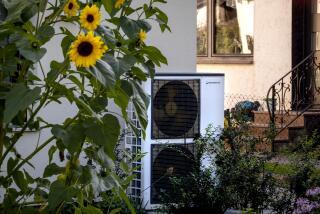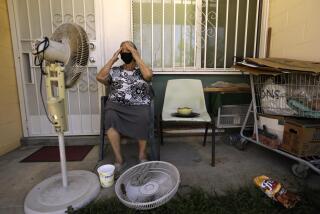Solar Collector Source of Free Heat for Pool
- Share via
QUESTION: I don’t like cool water in my swimming pool and I want to be able to extend my swimming season, but it costs a lot to heat it. Is there a simple solar system that I can make myself to heat the water?
ANSWER: Heating your swimming pool water can give you several more months or year-round use of it. Unfortunately, it is expensive for the fuel to heat the water, and swimming pools are not very energy-efficient. They seem to lose heat almost as quickly as you supply it.
You can easily build several types of solar swimming pool heating systems yourself, from simple to automatic-controlled ones. Once you build and install one, the heat is practically free.
You can either build simple solar collectors yourself or purchase them individually. Your existing filter pump circulates the pool water through the collectors, so you just need minor plumbing changes.
The simplest system just uses black hose coiled on top of a plywood platform. The water is warmed as it passes through the hose. Although it is not extremely energy-efficient, it is very inexpensive and does work. You will probably have to replace the hose every year or two because the pool chemicals slowly attack it. A longer and fatter hose is better.
The best do-it-yourself solar pool-heating system uses inexpensive, purchased collectors and a temperature-controlled diverter valve. This valve allows water to pass through the collectors only when they get hot enough in the sun. A manual valve works, but it requires more monitoring.
This automatic diverter valve senses the temperatures of the water in the pool and the collectors. By monitoring these, it automatically determines when the pool water should flow through the solar collectors.
Install the plumbing so that the water leaving the pool filter flows through the diverter valve either up to the collectors or directly back into the pool. The automatic temperature sensor controls the diverter valve.
The best angle of tilt (from horizontal) for your solar collectors is roughly the latitude angle for your area, plus 5 to 10 degrees. That absorbs the most solar heat during late fall, winter and early spring.
Q: My central air conditioner unit is 10 years old and I want to replace it before next summer. What are the highest efficiency air conditioners made and how can I compare the operating cost of various ones?
A: With a 10-year-old central air conditioner, it might be a good idea to replace it even if it still seems to be working properly. Within the past 10 years, there have been significant improvements and increases in efficiency. The lower operating costs may justify replacement now.
The energy efficiency (and resultant operating costs) is rated by a figure called seasonal energy efficiency ratio (SEER). The SEER figure indicates the amount of cooling output divided by the amount of electricity used.
An air conditioner with a higher SEER is cheaper to operate than one with a lower SEER. For example, one with a SEER of 12 costs 33% less to operate than one with an SEER of 8. Any air conditioner with an SEER above 10 is considered to be high-efficiency.
Whenever you select a central air conditioner, make sure your contractor sizes it properly. Generally, he should use a detailed computerized analysis to size it. An air conditioner that is too large will cool your home, but it won’t adequately dehumidify the air. And one that is too small won’t be able to cool your home on the hottest days.
There are new types of super energy-efficiency variable-speed central air conditioners that can cut your air-conditioning costs and increase your comfort level significantly. These use special motors and controls.
This allows the compressor and blower fan speeds to vary automatically, depending on the cooling needs of your home at a specific time. Standard high-efficiency air conditioners either run at full speed or are off.
There are several advantages to using a variable-speed air conditioner. At lower cooling needs in your home, it runs longer at a lower speed. Overall, it uses less electricity and you’ll feel more comfortable. The indoor temperature and air circulation stay more constant and the air is dehumidified better.
Also, at the lower speed, the noise level of the air from the registers is lower because the blower speed is reduced too. If you have allergies and use a furnace-mounted air cleaner, the longer running time provides better air cleaning.
You can write to me for Utility Bills Update No. 35 showing a list of manufacturers and model numbers of the highest-efficiency central air conditioners, information on the new variable-speed models, and a chart showing the operating costs for the various SEER ratings. Please include $1 and a self-addressed envelope.
Letters and questions to Dulley, a Cincinnati-based engineering consultant, may be sent to James Dulley, Los Angeles Times, 6906 Royalgreen Drive, Cincinnati, Ohio 45244.
More to Read
Sign up for Essential California
The most important California stories and recommendations in your inbox every morning.
You may occasionally receive promotional content from the Los Angeles Times.






